Circular & Square Barrows
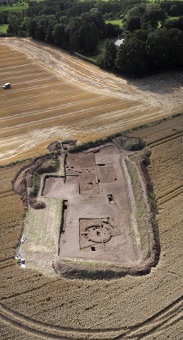
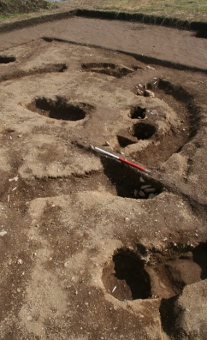 The cemetery consists of both square and round barrows as well as unenclosed burials, all of which appear to be extended inhumations. Barrows are monumental burials, with a large central earthen mound placed over the burial and a surrounding ditch. Unlike the enclosed graves, the barrows would have been very conspicuous – and appears to have been constructed for a select few.
The cemetery consists of both square and round barrows as well as unenclosed burials, all of which appear to be extended inhumations. Barrows are monumental burials, with a large central earthen mound placed over the burial and a surrounding ditch. Unlike the enclosed graves, the barrows would have been very conspicuous – and appears to have been constructed for a select few.
Some 5m to the east of the square enclosure a round barrow, defined by a continuous circular ditch, was excavated. The central grave was aligned east to west but no human remains were found here. When the grave was partly filled, two burnt wooden artefacts were deposited and may suggest a particular burial rite associated with this barrow. These wooden remains were dated to the 4th/5th centuries AD, suggesting this was an early element of the cemetery.
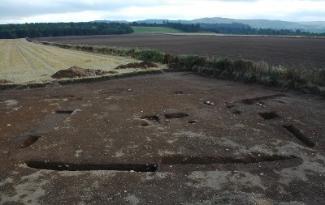
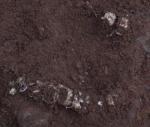 Two conjoined square barrows dating to the 8th/9th centuries AD were also excavated in the northern cemetery area. The barrows measured approximately 8m square, with causeways across the ditches at each corner. Although the orientation and character of both barrows mirrored one another, there were several irregularities, suggesting that the eastern one was built later than the other. Within each of the barrows the central grave was aligned east to west and surrounded by an unusual four ‘post’ setting. Only the very outer enamel of teeth survived of the interred body and no associated graves goods were found.
Two conjoined square barrows dating to the 8th/9th centuries AD were also excavated in the northern cemetery area. The barrows measured approximately 8m square, with causeways across the ditches at each corner. Although the orientation and character of both barrows mirrored one another, there were several irregularities, suggesting that the eastern one was built later than the other. Within each of the barrows the central grave was aligned east to west and surrounded by an unusual four ‘post’ setting. Only the very outer enamel of teeth survived of the interred body and no associated graves goods were found.
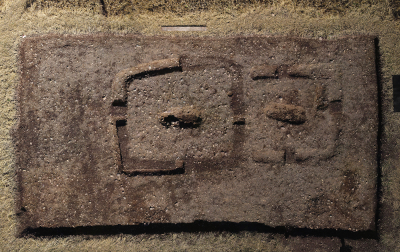
Excavations in 2010 explored two other conjoined ‘Pictish’ square barrows, some 0.5km south of the northern cemetery, located just outside the line of where the massive prehistoric palisaded enclosure would have stood.
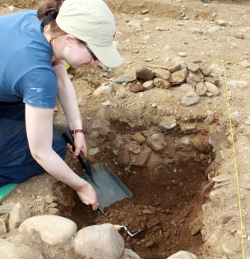 Unlike the square barrows explored in the northern cemetery these examples were almost half as small at around 5 metres square and, most notably, they did not have causeways at the corners of their ditches. Defined by a continuous ditch, the barrow to the west was not a true square. The eastern (slightly smaller and squarer) barrow appears to have been added at a later date. Although these barrows have not yet been dated, their form suggests they are early. Despite very poor preservation both central burials yielded traces of wooden coffins, possibly log burials. Both burials also produced remains of outer teeth enamel from the inhumation. Rounded stones along the edge of this grave cut suggest the coffin was packed with stone.
Unlike the square barrows explored in the northern cemetery these examples were almost half as small at around 5 metres square and, most notably, they did not have causeways at the corners of their ditches. Defined by a continuous ditch, the barrow to the west was not a true square. The eastern (slightly smaller and squarer) barrow appears to have been added at a later date. Although these barrows have not yet been dated, their form suggests they are early. Despite very poor preservation both central burials yielded traces of wooden coffins, possibly log burials. Both burials also produced remains of outer teeth enamel from the inhumation. Rounded stones along the edge of this grave cut suggest the coffin was packed with stone.
Report Links
- 2007 FC07 DSR
- 2009 FC09 DSR
- 2010 FN10.08 DSR
- Radiocarbon Dates
- Geophysical Survey

